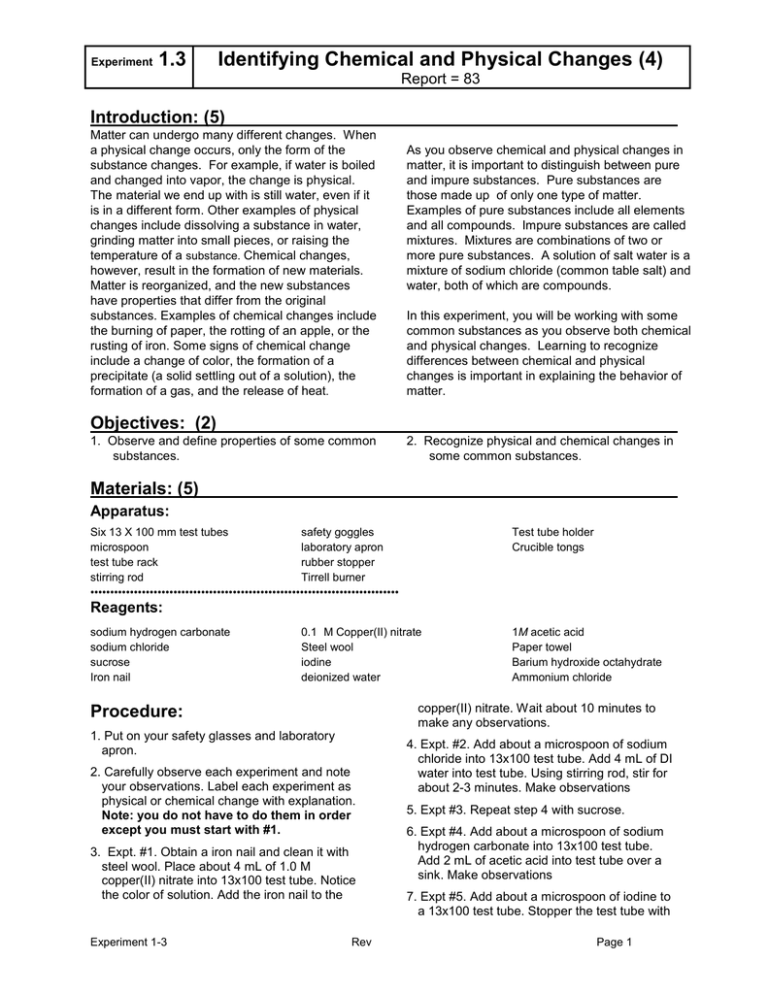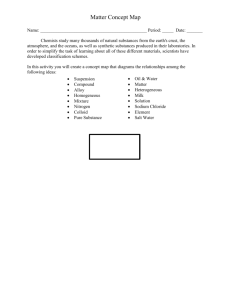1.3 Identifying Chemical and Physical Changes (4) Introduction: (5)
advertisement

Experiment 1.3 Identifying Chemical and Physical Changes (4) Report = 83 Introduction: (5) Matter can undergo many different changes. When a physical change occurs, only the form of the substance changes. For example, if water is boiled and changed into vapor, the change is physical. The material we end up with is still water, even if it is in a different form. Other examples of physical changes include dissolving a substance in water, grinding matter into small pieces, or raising the temperature of a substance. Chemical changes, however, result in the formation of new materials. Matter is reorganized, and the new substances have properties that differ from the original substances. Examples of chemical changes include the burning of paper, the rotting of an apple, or the rusting of iron. Some signs of chemical change include a change of color, the formation of a precipitate (a solid settling out of a solution), the formation of a gas, and the release of heat. As you observe chemical and physical changes in matter, it is important to distinguish between pure and impure substances. Pure substances are those made up of only one type of matter. Examples of pure substances include all elements and all compounds. Impure substances are called mixtures. Mixtures are combinations of two or more pure substances. A solution of salt water is a mixture of sodium chloride (common table salt) and water, both of which are compounds. In this experiment, you will be working with some common substances as you observe both chemical and physical changes. Learning to recognize differences between chemical and physical changes is important in explaining the behavior of matter. Objectives: (2) 1. Observe and define properties of some common substances. 2. Recognize physical and chemical changes in some common substances. Materials: (5) Apparatus: Six 13 X 100 mm test tubes safety goggles microspoon laboratory apron test tube rack rubber stopper stirring rod Tirrell burner •••••••••••••••••••••••••••••••••••••••••••••••••••••••••••••••••••••••••••••• Test tube holder Crucible tongs Reagents: sodium hydrogen carbonate sodium chloride sucrose Iron nail 0.1 M Copper(II) nitrate Steel wool iodine deionized water copper(II) nitrate. Wait about 10 minutes to make any observations. Procedure: 1. Put on your safety glasses and laboratory apron. 2. Carefully observe each experiment and note your observations. Label each experiment as physical or chemical change with explanation. Note: you do not have to do them in order except you must start with #1. 3. Expt. #1. Obtain a iron nail and clean it with steel wool. Place about 4 mL of 1.0 M copper(II) nitrate into 13x100 test tube. Notice the color of solution. Add the iron nail to the Experiment 1-3 1M acetic acid Paper towel Barium hydroxide octahydrate Ammonium chloride Rev 4. Expt. #2. Add about a microspoon of sodium chloride into 13x100 test tube. Add 4 mL of DI water into test tube. Using stirring rod, stir for about 2-3 minutes. Make observations 5. Expt #3. Repeat step 4 with sucrose. 6. Expt #4. Add about a microspoon of sodium hydrogen carbonate into 13x100 test tube. Add 2 mL of acetic acid into test tube over a sink. Make observations 7. Expt #5. Add about a microspoon of iodine to a 13x100 test tube. Stopper the test tube with Page 1 a stopper that has no holes. Set-up your Tirrell burner. Gently heat the test tube. Hold the test tube about 6 inches above the flame for about 1-3 minutes. Allow to cool and place back into test tube rack. Make observations throughout the whole experiment. 8. Expt #6. Set up Tirrell burner. Using crucible tongs take about a 5 cm by 5 cm paper towel and set it on fire. Make observations. 9. Expt. #7. Mass 4 grams of barium hydroxide and add it to a clean, dry 50 mL beaker. Mass 2.75 grams of ammonium chloride and add it the same 50 mL beaker. Using a stirring rod, gently but vigorously stir the solids together for 3-5 minutes. Make observations. 10. Get stamp and clean up all material and wash hands. ••••••••••••••••••••••••••••••••••••••••••••••••••••••••••••••••••••••••••••••• Data and Observations: (38) (28) Data Experiment Observation (14) Physical or Chemical. Explain! (14) (10) Stamp............….......... Analysis and Conclusions: (19) (10) 1. Summarize the chemical changes you have observed in this experiment. (2) 3. What is the major gas produced when burning paper? (5) 2. Summarize the physical changes you observed in this experiment. (2) 4. What would the major use for experiment #7? Synthesis: (17) (2) 1. What metal was formed on the iron nail? (2) 2. How could you recover sucrose or sodium chloride once it has dissolved in water? of a slow reaction and one example of a fast reaction, other than the chemical reactions you observed in this experiment. (9) 3. What are the chemical formulas for each of the substances you used in this experiment: iron sucrose acetic acid sodium hydrogen carbonate sodium chloride iodine barium hydroxide ammonium chloride water (4) 4. Think about some fast and slow reactions you have observed in the last 24 hours. Give one example Experiment 1-3 Rev Page 2




